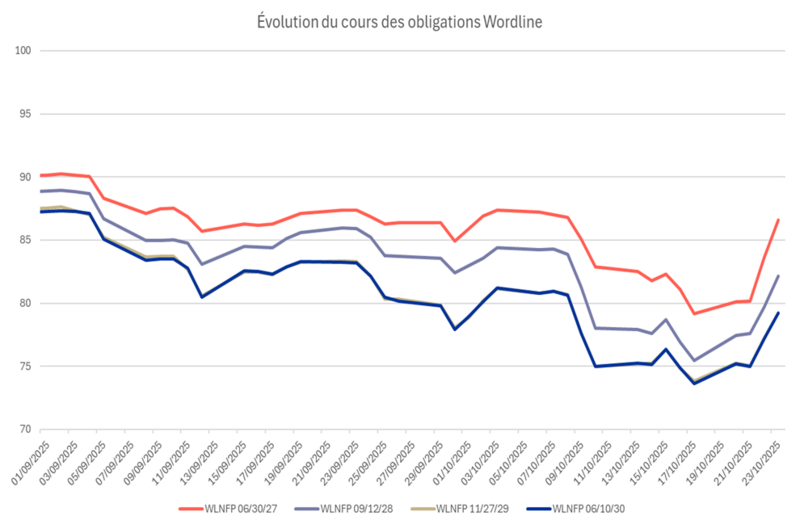24 October 2025
Worldline, relief on credit
Judging by investors’ reaction, whether creditors or shareholders, Worldline's latest earnings report was convincing. Within a few hours, the group's bonds climbed 4 to 7 % and its share price rose by more than 15%. All this for third-quarter revenue down 0.8% organically to €1.1 billion and a slightly downward revision of the 2025 outlook : slightly lower growth and adjusted EBITDA slightly above €800 million. Nothing to get excited about, then, but analysts saw it as a sign of stabilization: the decline in Merchant Services (-3.5%) appears to be slowing, while Financial Services continue to erode (-4.5%), but this time without surprise.

Sources : Bloomberg, Amplegest
Management, meanwhile, remained confident: “The initial measures are beginning to bear fruit.” These measures include a divestment program—after selling its Mobility & Web Transaction Services division to Magellan Partners, Worldline entered into exclusive negotiations with Shift4 to sell its North American operations (enterprise value: €70 million, or 8.8x EBITDA). In total, the group hopes to generate €300-350 million in net proceeds from disposals by 2026, which will “strengthen its liquidity” and “simplify its structure.” It should be noted, however, that the group's assets are said to be worth nearly €12 billion and its net debt is around €2 billion... €70 million is therefore a mere drop in the ocean...
The independent audits undertaken by Accuracy and Oliver Wyman also provided some welcome relief, as the main concern was the rumors of fraud that had roiled the markets before the summer, reviving the specter of Wirecard: no major exposure to high-risk clients, no immediate compliance threat—although the group will still have to invest in this area at the expense of its liquidity generation. The market applauded, relieved that the “cash pooling” storm revealed by the Financial Times this summer seems to be better understood: the system has been “functional for ten years” and is based on a notional rather than physical cash pool. In short, the audits are positive, explanations have been provided, and promises abound: the capital structure will be “addressed at Capital Markets Day” and the transformation “is underway” – again...
However, the figures paint a less rosy picture. The expected free cash flow of between €20 million and €100 million does not really allow for much breathing room on a turnover of €4 billion: this is barely a rounding error, not a sign of meaningful margin generation. By way of comparison, between 2019 and 2022, Worldline generated €200 to €700 million in free cash flow per year – enough to measure the decline. This is especially true given that the cost of debt has skyrocketed from 2–3% to around 11% on the secondary market, making any ordinary refinancing operation virtually impossible. As long as the historical stock of low-interest debt remains, the group can keep up appearances, but the reopening of financing at 11% or even between 7% and 10% would instantly wipe out what remains of its positive cash flow.
The balance sheet is no more comforting: of €12 billion in assets, €11 billion are intangible, including €9 billion in goodwill—an amount that has remained unchanged since 2021, despite three years of successive “transformation plans.” In 2019, during a period of solid organic growth, goodwill was only €3 billion. In other words, €6 billion in expected assets accumulated through acquisitions without ever being converted into tangible value. The markets now seem convinced that this time, management will succeed in turning promise into performance. This is bold, not to say naive, on the part of investors who have already seen this play before – and its sequel.
In summary: revenues are falling, disposals may bring in around €300 million, or 15% of total net debt and 2.5% of the company's assets, audits are reassuring, and investors are welcoming the “return of confidence.” But cash flow remains virtually zero, debt is too expensive, the balance sheet is largely intangible, and margins are too thin to absorb even the slightest slip-up. Even at a yield of 11% and with bonds heavily discounted compared to their BB rating offered by agencies, we consider that the former Atos subsidiary is not a “value” investment for a bond investor but rather a significant “value trap” risk.
Mathieu Bailly









